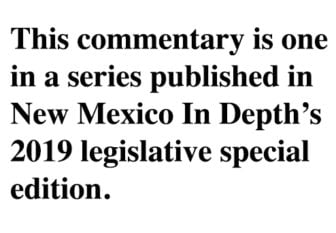One of this session’s top priorities will be increasing New Mexico’s education funding in the wake of the recent Yazzie court decision that found that New Mexico is failing to spend enough money on programs that improve outcomes for at-risk students.
Gov. Michelle Lujan Grisham, as well as many new and returning legislators, have been strong advocates for increasing spending in the classroom, especially on proven programs like high-quality early childhood education.

Fred Nathan is executive director of Think New Mexico
Unfortunately, in recent years, too much of New Mexico’s education budget has been spent on things that don’t make a difference for students.
Between 1993 and 2015 (the most recent year for which national data is available), New Mexico rose from 44th in the nation to 35th in the nation for total annual spending per student, according to the National Center for Education Statistics.
Yet our graduation rates and math and reading scores continue to lag behind states that spend less per student.
New Mexico only spends an average of 57 percent of its education dollars on instruction, according to the National Center on Education Statistics. Another 13 percent goes to student support and instructional support. The remaining 30 percent of the education budget – nearly one out of every three dollars appropriated for education – is spent on administrative costs.
Even more concerning is that administrative spending has been growing at a faster rate than classroom spending in most districts. Between 2006-2007 and 2016- 2017, more than two-thirds of school districts across New Mexico (61 of 89) saw their administrative spending grow faster than their classroom spending, according to data obtained from the New Mexico Legislative Finance Committee. As Governor Lujan Grisham told the Albuquerque Journal last July, “The administrative overhead in our schools is outrageous.”
Think New Mexico is advocating for legislation that would limit the growth of administrative spending to no faster than the CPI (which increased by an average of 1.7 percent a year over the past decade). Classroom spending would not be limited.
So in good budget years like 2019, when additional resources are available for our schools, taxpayers can be assured that the vast majority of that funding will be directed to the classroom where the learning takes place, rather than getting lost in layers of administration. We define “classroom spending” as a broad category that includes all the elements of education that the research shows make an impact on student learning. Our definition includes not only instruction (teachers), instructional support (e.g., librarians), and student support (e.g., counselors, nurses), but also principals, since the research suggests that principals can have a powerful positive impact on student achievement.
As the Yazzie ruling put it: “The evidence demonstrated that money spent on classroom instruction programs such as quality pre-K, K-3 Plus, extended school year, and quality teachers can all improve the performance of at-risk students and overcome the gap caused by their backgrounds.”
 The Yazzie decision made it clear that New Mexico not only needs more money in its education budget: we also need to spend it better. We encourage parents and families across New Mexico to urge their legislators and Governor Lujan Grisham to respond to the landmark Yazzie decision by both increasing public school funding and also limiting the growth of administrative spending to make sure that those additional dollars actually reach our students in the classroom.
The Yazzie decision made it clear that New Mexico not only needs more money in its education budget: we also need to spend it better. We encourage parents and families across New Mexico to urge their legislators and Governor Lujan Grisham to respond to the landmark Yazzie decision by both increasing public school funding and also limiting the growth of administrative spending to make sure that those additional dollars actually reach our students in the classroom.
Fred Nathan is executive director of Think New Mexico, an independent, nonpartisan, results-oriented think tank serving New Mexicans. The views in this column are the author’s alone and do not reflect the view or opinions of New Mexico In Depth.
